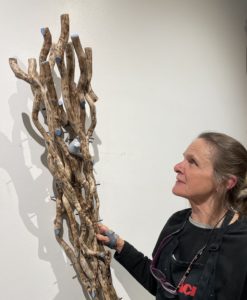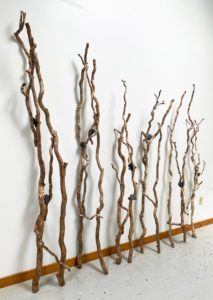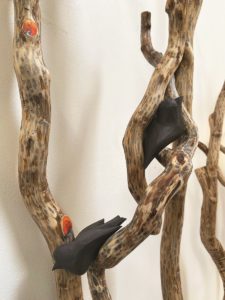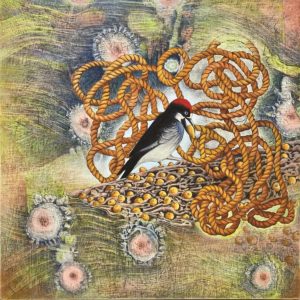“I’m not a city person,” says the artist Susan Lyman, chatting in the far East End Provincetown home she designed and built in 1987 with her late husband, Doug Trumbo, a local paramedic and carpenter. “I’m really inspired by the landscape — everything about it.”
These days, Lyman divides her time between the Cape, northern Michigan, and the Sonoran Desert outside Tucson, Ariz. “I go from one beautiful place to another,” she says.

During the isolation of Covid, she spent long periods walking in the woods and on beaches, observing the ominous effects of climate change. The artwork she created for her latest show, “Harbinger,” at the Boston Sculptors Gallery through Dec. 3, reflects that experience: sculptures of gnarly and twisted wood that she has foraged, carved, sanded, painted, and assembled, with surreal paintings to match.
Lyman has long been obsessed with the sculptural potential of trees and branches. Her woodworking got a jump start in the early ’80s. “Doug and I went to Wellfleet, around Thanksgiving, to get oysters from Joe Francis,” she recalls. “There was this amazing thicket of bittersweet. I said, ‘Joe, you’ve got all these shapes growing here. I might be able to use them.’ He said, ‘Go ahead — no problem.’ I filled up a truck with the stuff.”

Then she got to work. “I whittled the wood, colored it with oil paint in bright colors,” she says. “The figurative quality of these vines — the gestures! I always saw these as body-like. That’s what inspires me.”
Lyman was born in Boston and spent her early childhood in Cambridge. “My dad had gone to the Harvard Graduate School of Design,” she says. “He was an architect, studied with Gropius. He got a big job in Detroit when I was three or four. So, I pretty much grew up in Michigan.”

She was one of six children. “My mom was a painter,” she says. “A very good painter. She became a ‘Sunday painter’ when she had children. She would teach and paint at home, in between raising a family. She had a regional, professional career. She was definitely an inspiration.”
Among her siblings, Lyman was the only one who went to art school. “I went to the Rhode Island School of Design for two years,” she says. “It was during the Vietnam war. I really didn’t like the exclusiveness of RISD. These kids came there with credit cards. I was from a middle-class family, and I didn’t feel like I fit in. Especially with the war going on. I wanted to get more involved. So, I transferred to the University of Michigan. Got my B.F.A. in sculpture and ceramics.”
She worked and saved and spent a year with a boyfriend traveling around South America. “Then I went back to the University of Michigan and got my M.F.A. in ceramics and textiles,” she says. After that, she taught at Kirkland College — the defunct women’s counterpart to Hamilton — for five years.

“When Kirkland was closed, I spent a year in Provincetown with a boyfriend who was a fellow at the Fine Arts Work Center,” Lyman says. “I liked it here. I applied for a few years to the work center before I finally got a fellowship myself. And I stayed. I started teaching in Boston.”
When Lyman was building her house in Provincetown, she was 38 and pregnant. “I had my kids late,” she says. “I decided to be an artist and a mother and gave up my job. We just scraped along on the salary of a paramedic and carpenter. We put all our work into this house. I lost Doug 25 years ago to ALS.”
Lyman recently married Ken Stebbins, the boyfriend with whom she went to South America when they were in their 20s. “We both lost our spouses,” she says. “He’s been living in northern Michigan for quite some time. I originally met him there working as a summer waitress.” Stebbins winters in Tucson, which is what drew Lyman there. “The desert is so different,” she says. “I love it there. It’s magical.”

The natural landscape is not the only inspiration for Lyman’s work. She has collaborated with poets, and there’s often a literary component to her work. “A lot of it is related to what I read,” she says. She branched out into painting as a result of her time at the work center. “I was hanging around with all these painting fellows,” she says. “I thought, ‘I know how to paint. I know how to draw.’ I started doing it as a separate activity. I started making paintings that looked like possible sculptures.”
Her favorite artists are surrealists, she says, and her work comes together like a collage, with elements sourced by impulse. “This,” she says, pointing to one part of a painting, “is actually my mammogram. I asked them, ‘Can you just email that to me?’ When I do something like this, it’s not planned. I just go with it. I don’t know how it’s going to evolve, but I know that there are a lot of things that go into it.”
Knock on Wood
The event: “Harbinger,” a solo exhibit of paintings and wood sculptures by Susan Lyman
The time: Through Dec. 3; Wednesday to Sunday, 11 a.m. to 5 p.m.; reception Saturday, Nov. 13, 2 to 5 p.m.
The place: Boston Sculptors Gallery, 486 Harrison Ave., Boston
The cost: Free



